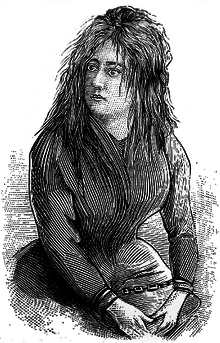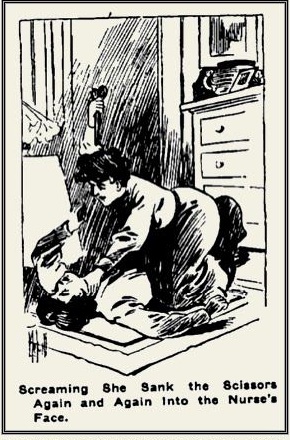Natural Born Killer | Elizabeth McNally’s lifelong killing spree
Elizabeth Margaret McNally died 100 years ago in the Summer of 1918 at the age of 59. The County Antrim lady is not known to many today, but at the turn of the 19th century she was dubbed ‘The worst woman on earth’ and became the first female to be sentenced to death by electric chair.
Her crime?
A string of ghastly murders across the United States.
Born in 1859 in Antrim, Elizabeth was around five years old when she emigrated with her parents and nine siblings across the broad Atlantic. The McNallys settled in New York City and, growing up in the immigrant melting pot of the Big Apple, Elizabeth developed a fearsome reputation. Her violent temper was well known and feared on the city streets but, it was an ugly characteristic which would result in her estrangement from her own family.
McNally left home while still a teenager after numerous physical altercations with family members and she went rambling around the eastern States until 1879 when she married Charles Hopkins in Pennsylvania. The couple had one son, but by 1881, Hopkins had died suddenly and McNally was a widow.

She did not remain a widow for long and went on to marry an elderly gentleman by the name of Artemus Brewer. Just months after the wedding, McNally’s second marriage was doomed by the sudden death of Brewer.
Not long afterwards, McNally was on to husband number three who came in the form of Hiram Parkinson. Just weeks in to the marriage he vanished without a trace.
Husband number four came along in the form of the Civil War veteran, George Smith. Months into the marriage, she spiked his tea with arsenic. Smith survived the attempt on his life and before he could bring his would be killer to justice, she had already fled, along with all of his money.
Months later, McNally emerged in Vermont where she married Charles Pleysteil, then however, she disappeared two weeks into the marriage. She resurfaced in 1888 in Philadelphia where she befriended Irish immigrant family the McQuillans.
McNally had changed her name to Maggie Hopkins and with the money she stole from previous husbands, she set up a shop which she later burned down in an insurance scam. Justice however was finally served to her on St Patrick’s Day of 1888 when McNally was convicted of arson. Sent to the Eastern state penitentiary, she was handed a two year sentence.
During her imprisonment, McNally’s son who had accompanied her during her rambles and marriages across the eastern United States, was carted off to a juvenile institution. Apparently, McNally’s son also carried the same violent traits as his mother.
When McNally was released she changed her name to Lizzie Brown and found employment as a housekeeper for elderly widower Paul Halliday who resided on a farm in Sullivan County, upstate New York. In 1890 she married him and became known as Lizzie Halliday, the name for which she would go down in the annals of criminal history.
On May 6th 1891 McNally burned down a portion of the Halliday family home. On May 26th she burned down one of the large barns on the farm and drove all of her husbands work horses to the town of Newburgh where she sold them. McNally also lashed out at Halliday’s older sons and had threatened Halliday with death on several occasions.
Suffice to say, it was a rocky marriage.
In 1893 McNally burned down her husband’s mill while his son John was inside. John, who was disabled, perished in the fire and McNally was arrested. She was deemed insane and sent to an asylum. She wasn’t there long when the authorities claimed she was cured and they released her.

McNally made her way back to Sullivan County in August of that year, the same month Paul Halliday mysteriously disappeared. Neighbours and family who witnessed McNally back on Hallidays farm, at the same time as his sudden disappearance, feared the worst and contacted the police. With a search warrant in hand, Sullivan County lawmen went searching the farm for Mr.Halliday but, instead they found Margaret and Sarah McQuillan. The lifeless bodies of the two Irish immigrant sisters were buried under hay in one of the barns. Both had been shot by a .32 Calibre five-shooter. The McQuillans who had befriended McNally in Philadelphia had been caught up in one of her throes of violence and neither survived.
Days later a stench coming from beneath the floorboards of the Halliday house drew the attention of the police. There they found the mutilated body of Paul Halliday. He too had been shot, but his body had been horrifically tampered with. When questioned, McNally spoke gibberish and tore off her clothes. Many considered it an act of faking insanity while others were of the opinion that she was, without doubt, off her mental reservation.
While in custody McNally refused to eat or talk. She tried to cut her throat with broken glass and set fire to her bed. McNally had to be restrained 24 hours a day by chains to the ground in her cell.
Media had a field day with this mad murdering Irish woman called ‘Lizzie Halliday’. Some tabloids claimed she had killed people in Belfast before arriving in the States but that claim was not true. Other news outlets even made claims that she had a connection to Jack the Ripper, a claim which is was also highly fictitious.
On June 21st 1894 after a trial which attracted swaths of media from around America and beyond, McNally was convicted at Sullivan County court house and sentenced to death by electric chair. Upon hearing the verdict, McNally lunged for Sheriff Harrison Beecher and bit his hand. The Sheriff’s hand and arm later got infected and the lawman lost it to amputation. Even under the control of the law, McNally was still causing mayhem and destruction.

McNally was the first female sentenced to die electric chair and it caused a sensation, so New York Governor Roswell Flower decided to commute her sentence to life in a mental institution. McNally was sent to Matewan State Hospital for the Criminally Insane where she remained for the rest of her life.
McNally’s murdering ways did not end there. In 1906 she stabbed a nurse in Matewan State Hospital. Nurse Nellie Wicks was jumped on by McNally who had stolen a scissors and with the deadly implement she stabbed the unfortunate nurse 200 times.
McNally had married six times. Two husbands had died suddenly. Two husbands disappeared. One was almost poisoned and another was shot dead. She had killed her step son in a fire while her own son was institutionalised. She shot dead two fellow immigrants and stabbed a nurse to death. The woman from County Antrim had the eastern States of America in a grip of terror in the late 19th century, and even when she was under lock and key she was still dishing out waves of violence.
Elizabeth McNally died on the 28th of June 1918 and was buried in an unmarked grave in the grounds of Matewan State Hospital.
